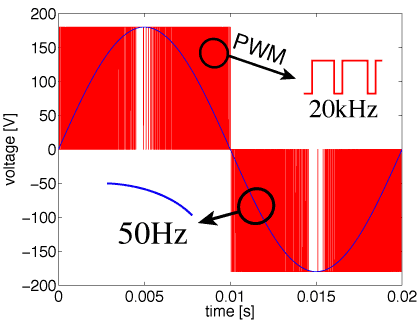Multirate

Highly integrated electric cicuits show a phenomenon called latency. That is, a processed signal causes activity only in a small subset of the whole circuit (imagine a central processing unit), whereas the other part of the system behaves almost constant over some time - is latent. Such an electric system can be described as coupled system, where the waveforms show different time scales, also refered to as multirate.
More generally, any coupled problem formulation due to coupled physical effects, may cause a multirate problem: image the simulation of car driving on the road, there you need a model for the wheel, the chassis, the dampers, the road,... (cf. co-simulation). Again each system is covered by their own time constant, which might vary over several orders of magnitude comparing different subsystems.
Classical methods cannot exploit this multirate potential, but resolve everything on the finest scale. This causes an over sampling of the latent components. In constrast, Co-simulation or especially dedicated multirate methods are designed to use the inherent step size to resolve the time-domain behaviour of each subystem with the required accuracy. This requires a time-stepping for each.
Group members working in that field
- Andreas Bartel
- Michael Günther
Former and ongoing Projects
Cooperations
- Herbert de Gersem, K.U. Leuven, Belgium
- Jan ter Maten, TU Eindhoven and NXP, the Netherlands
Publications
- 2025
5447.
Fan, Jilin; Lennarz, Regina; Zhang, Kuan; Mourran, Ahmed; Meisner, Jan; Xuan, Mingjun; Göstl, Robert; Herrmann, Andreas
Polymer microbubbles as universal platform to accelerate polymer mechanochemistry
Nature Communications, 16 (1) :5380
Juni 2025
ISSN: 2041-17235446.
Xu, Zhuo
Input-to-state type Stability for Simplified Fluid-Particle Interaction System
Mai 20255445.
Asya, Berçin V.; Wang, Sitao; Euchler, Eric; Khiêm, Vu Ngoc; Göstl, Robert
Optical Force Probes for Spatially Resolved Imaging of Polymer Damage and Failure
Aggregate, 6 (4) :e70014
April 2025
ISSN: 2692-45605444.
Hahmann, Johannes; Schüpp, Boris N.; Ishaqat, Aman; Selvakumar, Arjuna; Göstl, Robert; Gräter, Frauke; Herrmann, Andreas
Sequence-specific, mechanophore-free mechanochemistry of DNA
Chem, 11 (4) :102376
April 2025
ISSN: 2451-9294, 2451-93085443.
Ocqueteau, Vicente; Tucsnak, Marius
On an Initial Value Problem Describing the Small Oscillations of a Floating Cylinder
April 20255442.
Solid-Supported Iodine(V) Reagents in Organic Synthesis
Chemistry - A European Journal, 2025 :e202500670
03 2025
Herausgeber: Wiley
ISSN: 1521-37655441.
[German] Grandrath, Rebecca; Wiebel, Michelle; Bensberg, Kathrin; Schebb, Nils Helge; Bohrmann-Linde, Claudia
Aus der Schale in die Schule
Nachrichten aus der Chemie, 73 (3) :10-12
März 20255440.
Storch, Sonja; Campagna, Davide; Aydonat, Simay; Göstl, Robert
Mechanochemical generation of nitrogen-centred radicals for the formation of tertiary amines in polymers
RSC Mechanochemistry, 2 (2) :240-245
März 20255439.
Aus der Schale in die Schule
Nachrichten aus der Chemie, 2025 :10-12
02 2025
Herausgeber: Wiley
ISSN: 1868-00545438.
Clevenhaus, A.; Totzeck, C.; Ehrhardt, M.
A Space Mapping approach for the calibration of financial models with the application to the Heston model
20255437.
Gaul, Daniela; Klamroth, Kathrin; Pfeiffer, Christian; Stiglmayr, Michael; Schulz, Arne
A Tight Formulation for the Dial-a-Ride Problem
European Journal of Operational Research, 321 (2) :363-382
2025
ISSN: 0377-22175436.
Könen, David; Stiglmayr, Michael
An output-polynomial time algorithm to determine all supported efficient solutions for multi-objective integer network flow problems
Discrete Applied Mathematics, 376 :1—14
2025
Herausgeber: Elsevier BV
ISSN: 0166-218X5435.
Frommer, Andreas; Rinelli, Michele; Schweitzer, Marcel
Analysis of stochastic probing methods for estimating the trace of functions of sparse symmetric matrices
Math. Comp., 94 :801-823
20255434.
Hoffe, Leon; Ulutas, Berna; Klamroth, Kathrin; Bracke, Stefan
Assessing the effectiveness and efficiency of selected solution approaches for two-dimensional stock cutting problems (Part III): Hybrid Approach For Printed Circuit Boards
AUTOMATION 2025: Conference on Automation — Innovations and Future Perspectives
20255433.
Kiesling, Elisabeth; Bohrmann-Linde, Claudia
Carbon Capture and Storage - Nachweis von adsorbiertem Kohlenstoffdioxid
Naturwissenschaften im Unterricht Chemie, 1/25 :Versuchskarteikarte
Februar 20255432.
Clément, François; Doerr, Carola; Klamroth, Kathrin; Paquete, Luís
Constructing Optimal Star Discrepancy Sets
accepted in Proceedings of the AMS
20255431.
Kunze, Markus; Mui, Jonathan; Ploss, David
Elliptic operators with non-local Wentzell-Robin boundary conditions
20255430.
Song, Yongcun; Wang, Ziqi; Zuazua, Enrique
FedADMM-InSa: An Inexact and Self-Adaptive ADMM for Federated Learning
Neural Network, 181
Januar 20255429.
Kienitz, J; Moodliyar, L
Gaussian views explained
Wilmott, 2025 (135) :72–77
2025
Herausgeber: Wilmott Magazine5428.
Xu, Zhuo; Tucsnak, Marius
Global Exponential Stabilization for a Simplified Fluid-Particle Interaction System
Januar 20255427.
Bartel, Andreas; Schaller, Manuel
Goal-oriented time adaptivity for port-Hamiltonian systems
Journal of Computational and Applied Mathematics, 461 :116450
2025
ISSN: 0377-04275426.
Schäfers, Kevin; Finkenrath, Jacob; Günther, Michael; Knechtli, Francesco
Hessian-free force-gradient integrators
Computer Physics Communications, 309 :109478
2025
ISSN: 0010-46555425.
Schäfers, Kevin; Finkenrath, Jacob; Günther, Michael; Knechtli, Francesco
Hessian-free force-gradient integrators
Computer Physics Communications, 309 :109478
2025
ISSN: 0010-46555424.
Schäfers, Kevin; Finkenrath, Jacob; Günther, Michael; Knechtli, Francesco
Hessian-free force-gradient integrators and their application to lattice QCD simulations
PoS, LATTICE2024 :025
20255423.
Schäfers, Kevin; Finkenrath, Jacob; Günther, Michael; Knechtli, Francesco
Hessian-free force-gradient integrators and their application to lattice QCD simulations
PoS, LATTICE2024 :025
2025
